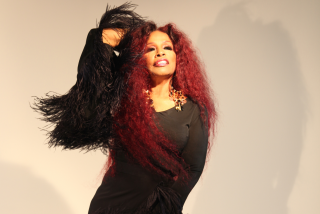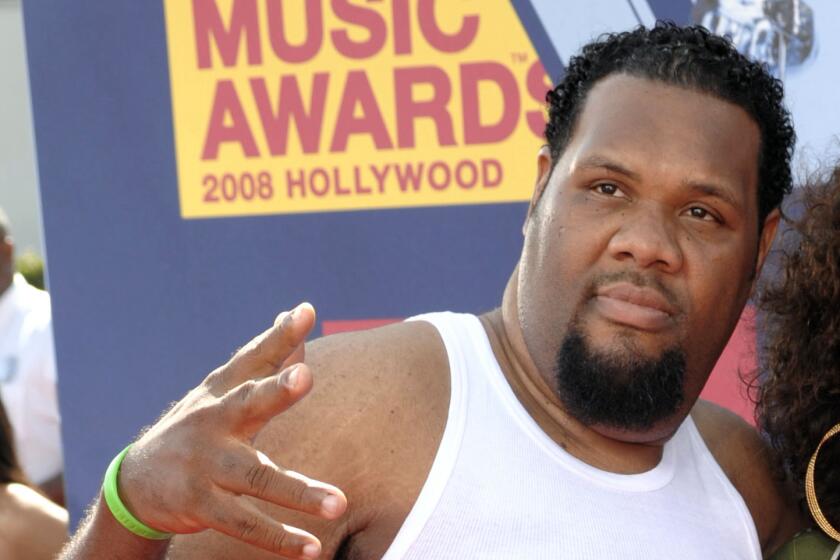Herbie Hancock hits 70 on a high note
When journalists ask Herbie Hancock which musicians he listens to, he thinks that they’re expecting him to say Oscar Peterson and Chick Corea -- that is, virtuoso jazz pianists like himself.
“I do listen to those musicians,” Hancock said recently, savoring some morning downtime in his Westside home’s tranquil garden filled with African sculptures and sashaying felines. “But there’s more than that. Actually, what I try to listen to is life.”
Life must be sounding pretty good to Hancock these days, and not only because as a practicing Buddhist for 38 years he cultivates personal equanimity like a well-tended flower bed.
On April 12, Hancock turned 70, a passage that’s prompting splashy official and semi-official musical tributes across the continent. And although he looks easily a decade younger, he’s embracing the occasion.
Last month he was feted at Carnegie Hall. On Sept. 1 he’ll be the pièce de résistance of the Hollywood Bowl program Herbie Hancock: Seven Decades -- The Birthday Celebration,” in which he’ll perform with saxophonist nonpareil Wayne Shorter (Hancock’s former cohort in Miles Davis’ “Second Great Quintet”https://en.wikipedia.org/wiki/Miles_Davis_Quintet) and the wife-husband blue-eyed soul/blues/rock artists Susan Tedeschi and Derek Trucks.
Hancock also is marking the launch of his eighth decade with the release of his latest record, “The Imagine Project” (issued on his personal label, Hancock Records), and an extensive summer tour that will take him from Beaver Creek, Colo., to Bratislava in the Slovak Republic.
“I’ve got this window of all of this year and part of next year up ‘til April 12,” he said, referring to the marathon merrymaking. “I’m trying to milk that sucker for everything it’s got!”
The Bowl’s Sept. 1 encomium coincides with Hancock’s appointment last year as the Los Angeles Philharmonic’s creative chair for jazz. In that post, previously held by vocalist Dianne Reeves and bassist Christian McBride, he’ll oversee programming for jazz concerts both at the Bowl and Walt Disney Concert Hall during his two-year tenure.
A lifelong self-identified “techie,” Hancock said that, in addition to pushing the mix of guest jazz musicians at the Bowl and Disney Hall, he’s hoping to incorporate more dance and performance, as well as computer graphics and film clips, into jazz presentations.
“The idea of employing visuals is two things,” he said. “One of them is: other ways to attract an audience, other pathways that they can use in order to get to the heart of the music. And it’s also the 21st century. It’s not like 40 years ago, it would’ve been just financially impossible to do. A blank CD costs, what, 25 cents? A blank DVD costs maybe, what, 50? So all of the prices for the technology, it’s all come down.”
Although the classically trained Hancock has explored R&B, pop, rock and world beat, jazz remains the alpha and omega of his career, “the springboard for any project that I do.” And it’s a springboard with a very broad base. Although other jazz orchestras and programs, such as Jazz at Lincoln Center, have attempted to articulate a sort of classic jazz canon over the years, Hancock is careful in avoiding drawing boundaries about what jazz is or isn’t.
“If you feel it’s necessary for you, in your own mind, to define jazz, make sure that the definition is broad enough,” he said. “I think you’re putting the death knell on jazz when you try to narrow it. It’s not the nature of jazz to be narrow.”
In keeping with that expansive view, Hancock is frank in acknowledging how jazz and jazz audiences have changed over the years, and must continue to do so.
“The mainstream jazz audience, just like the musicians that have come through or from the mainstream, including myself, we’re getting older and older, right? And we’re dying off, you know? It’s a natural process of life. But the audiences are getting older and older too. And they’re dying off, right?”
Part of the genre’s regeneration, Hancock believes, will come from outside the country where jazz was born. “Jazz is a gift of America to the world, and it has affected people from all cultures. That’s why the new flock of jazz musicians is not just coming from America. They’re from all over the planet now.”
Reflecting that reality, his first-year’s programming for the Phil is integrating such genre-stretching artists as the reggae-pop-rock influenced Jason Mraz and the Grammy Award-winning gospel-R&B singer BeBe Winans. Other performers will include Nancy Wilson, Lula Washington Dance Theatre and Trey McIntyre Dance Project.
Quincy Jones, who has known Hancock since they were both rising young Chicago players and calls him “my brother from another mother,” is eager to see what his friend will bring to the Bowl and Disney Hall over the next two years.
“He can do it all,” Jones said. “He hasn’t talked to me about any plans, but Herbie will try anything he feels, man.”
Deborah Borda, the Phil’s president and chief executive, said that although the job’s “basic duties haven’t really changed” since the position’s inception, each of the creative chairs for jazz has brought specific new ideas and collaborators into the mix.
As one example, she cited a 2006 Bowl program in which James Brown performed music from “Soul on Top,” his 1969 funk-meets-big-band album, for the first time in public. That event, Borda said, “absolutely would not have happened without Christian McBride,” a huge Brown buff who’d been involved in the 2004 CD reissuing of “Soul on Top,” which had been out of print for decades.
Borda also pointed to the performance of a piece by L.A. pianist Billy Childs that Reeves had commissioned. She’s expecting similarly fruitful collaborative ventures from the artistically well-connected Hancock, as is his friend Reeves.
“The beautiful thing about Herbie is he views music without boundaries and he loves making music with everybody,” said Reeves, who’ll be performing Wednesday at the Bowl in one of Hancock’s programs that also will include Lee Ritenour, Dave Grusin and Taj Mahal. “He has this ability to put people together who wouldn’t ordinarily be together.”
Few ventures in Hancock’s voluminous career demonstrate that more than “The Imagine Project,” which takes its title from John Lennon’s paean to a possession-less world living as one. Jeff Beck, Chaka Khan, Oumou Sangare, India.Arie, John Legend, the Chieftains, Los Lobos, the Brazilian chanteuse Cèu and the Colombian rocker Juanes were among the all-star project’s contributors.
“This record is like a call to arms, in many ways,” Hancock said. “If we don’t want globalization to be what we don’t want, why don’t we create the globalization we do want?”
Of course, coordinating recording sessions with a group of artists separated by multiple time zones can be almost as tricky as, say, getting the U.S. and China to concur on trade policy. Although he described the record-making process as enjoyable overall, Hancock said that he and his team “ran into some huge obstacles at the worst time” in getting the disc to hit its production deadline.
“Things started falling apart, almost like unraveling,” he said. “A lot of the people on my team are like flipping out. And I’m really glad I practice Buddhism because I didn’t flip out.”
Hancock’s chilled-out outlook also derives from his sense of connection to life’s mundane rhythms. He absorbed that ability from one his foremost teachers, Miles Davis.
“If you’re walking down the street with Miles, and you get to a corner, and somebody else is walking and you both happen to see this person, and they sort of make a misstep and they stumble, Miles would say, ‘Play that!’”
Hancock, grinning, affected Davis’ raspy whisper. “I mean, who else would think like that, you know? Like, ‘Do that musically!’ Because that’s life.”
At least it is for those who, like Hancock, have the ears to hear it.
More to Read
The biggest entertainment stories
Get our big stories about Hollywood, film, television, music, arts, culture and more right in your inbox as soon as they publish.
You may occasionally receive promotional content from the Los Angeles Times.










